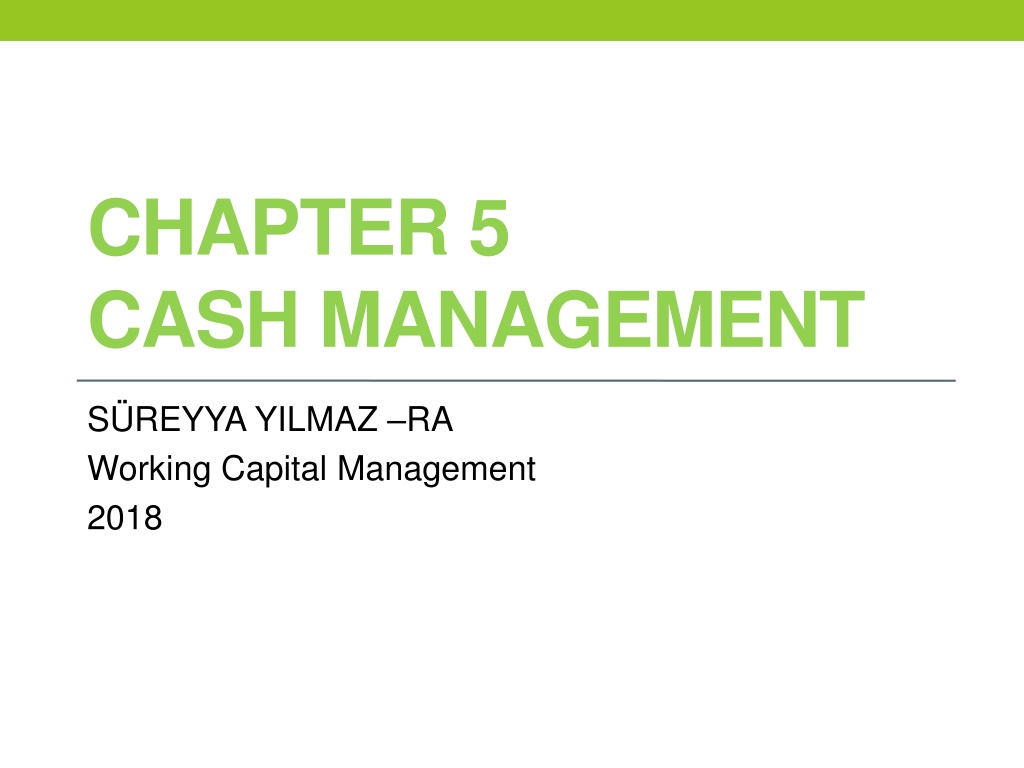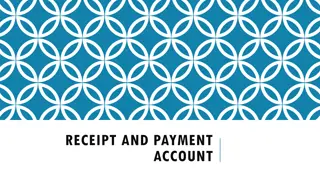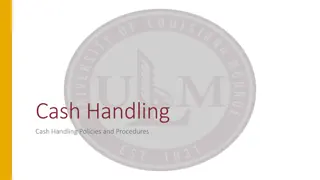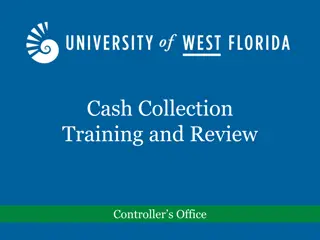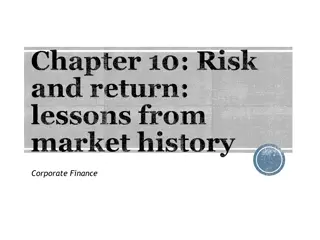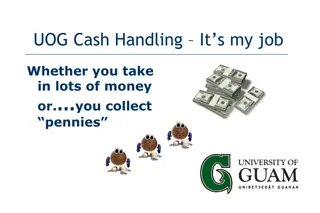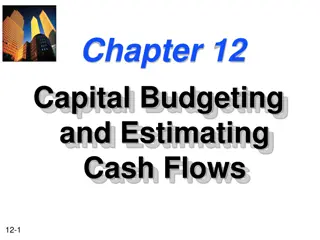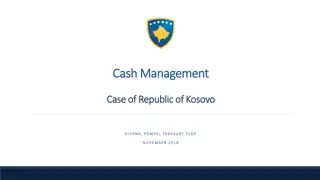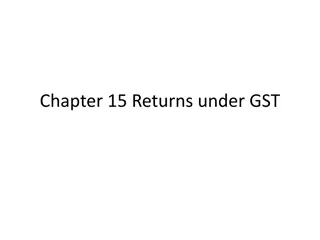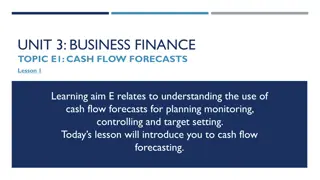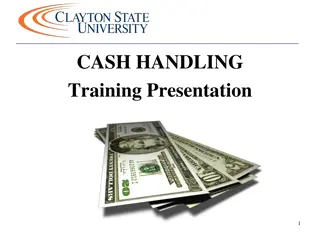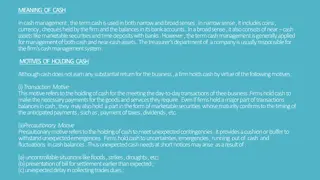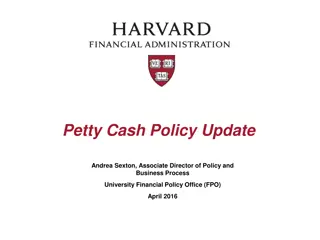The Importance of Cash Management in Generating Returns
Firms hold assets, including cash, for various reasons such as generating returns, facilitating transactions, and responding to unexpected events. This article explores the transaction, precautionary, and speculative motives for holding cash to support the firm's financial operations. By managing cash effectively, firms can enhance their ability to seize profit-enhancing opportunities and navigate financial uncertainties.
Download Presentation

Please find below an Image/Link to download the presentation.
The content on the website is provided AS IS for your information and personal use only. It may not be sold, licensed, or shared on other websites without obtaining consent from the author.If you encounter any issues during the download, it is possible that the publisher has removed the file from their server.
You are allowed to download the files provided on this website for personal or commercial use, subject to the condition that they are used lawfully. All files are the property of their respective owners.
The content on the website is provided AS IS for your information and personal use only. It may not be sold, licensed, or shared on other websites without obtaining consent from the author.
E N D
Presentation Transcript
CHAPTER 5 CASH MANAGEMENT S REYYA YILMAZ RA Working Capital Management 2018
Why does the firm hold assets? One main reason: to generate returns. As such, the value of an asset is determined according to its capacity to generate future cash flows.
If the main goal is to distribute profits to investors, why do firms choose to hold cash? Perhaps the first idea that comes to mind is that cash is needed to perform transactions, for example, to pay general expenses and wages or to make purchases.
Of course, in some cases a firm may be able to effect these transactions using credit rather than cash, but eventually such obligations need to be paid. Thus, as long as the company operates, there is a transaction motive for holding cash.
Second, a firm will need to hold some cash to be able to respond to the unexpected. On the one hand, an unexpected event may be bad. For example, if a large customer fails to pay on time. In this case, the firm will be able to pay its bills only if it has sufficient back-up money available. This is typically referred to as a precautionary motive for holding cash.
On the other hand, an unexpected event may be good. If a firm faces a profit-increasing investment opportunity. To the extent that pursuing such opportunities requires cash, the firm may choose to hold higher cash balances simply to be able to profit from this valuable option.
Note that the option motive for holding cash is close to, but richer than, the typical speculative motive for holding cash. Related to the previous concept, a firm may hold cash balances to use as a hedging tool . In particular, a firm that generates volatile (unpredictable) cash flows may choose to hold higher cash balances.
TRANSACTION, PRECAUTIONARY, AND SPECULATIVE MOTIVES FOR HOLDING CASH Generating returns is one of the main objectives of a firm. Returns are computed by taking the ratio between the profits that have been generated and the corresponding investment (e.g., return on assets [ROA] is computed as ROA = operating profits / net assets), the lower the investment is, holding everything else constant, the higher the returns.
Therefore, given that cash holdings represent part of the firm s necessary investment, it is extremely critical to optimize this balance. Failing at this task would imply either holding assets that are costly to finance and that generate minimal returns or holding an insufficient amount of cash, causing shortfalls of critical value. Cash management is about managing this trade-off.
The Transaction Motive The most common way of thinking about the transaction motive for holding cash is to use the famous Baumol model. The fundamental idea of this model is that a firm needs cash to run its business. For this purpose it sets an initial amount of cash, which is used over time while the firm performs sequential transactions.
At some point, the cash balance reaches zero or a minimum optimal level, in which case the firm needs to replenish its cash balance and restart the cycle. There are two basic costs associated with this routine. First, the average balance held by the firm should pay its corresponding opportunity cost. Second, every time the balances, it faces some direct trading or administrative costs. firm replenishes its cash
The first cost is an increasing function of average cash holdings (i.e., a higher cash balance implies a higher opportunity cost); The second cost is decreasing on average cash holdings (i.e., a higher balance implies less of a need to liquidate assets or run to the bank).
Lets look at an example. Imagine a firm needs $200 a week to pay for its transactions (i.e., weekly inflows fall $200 short of weekly outflows). If the firm chooses to start by setting a cash balance equal to $800, its cash will be exhausted in four weeks. At that time, it will need to replenish its cash account to start all over. Under this setting, the cash balance will move, over a four-week period, from $800 to zero. If one thinks of the payment stream as being smooth, the average cash balance will be $400.
The opportunity cost of holding the average cash balance is a function of the average return the firm can expect to earn by investing its assets, r . Thus, the total opportunity cost of holding cash is estimated as: ??????????? ???? =? 2? ? C is the initial cash balance and r is the return obtainable by noncash investments.
Now imagine that the firm faces trading or administrative costs, tc, every time it replenishes its cash balance (either by selling other assets or by borrowing money from a bank). To measure total trading or administrative costs, we need to determine the number of times the firm actually needs to replenish its cash balances over the year.
To estimate this number, we simply divide the total amount of cash the firm will be using over the year, T, by the amount of cash that is picked up each time, C . Trading costs can then be estimated as: ??????? ???? =? ?? ?? T is the total amount needed during the reference period, C is the initial balance at the beginning of each period, and tc is the trading or administrative cost the firm faces each time it replenishes the cash account.
In our example, given that the total amount of cash required by the firm over the year is $10,400 (= $200 per week 52 weeks), and given that each time the firm picks up cash it obtains $800, we can conclude that the firm will pay trading or administrative costs 13 times a year. If we assume these costs are equal to $100, then total annual administrative costs will amount to $1,300.
Putting everything together, the cash manager should try to choose the level of cash balances, C, that minimizes the following total cost function: ????? ???? =? 2? ? +? ?? ?? Figure 5.1 depicts the total cost function and its individual components.
The following formula gives the optimal (cost-minimizing) cash balances: 2??? ?? ? ? =
According to this expression, the optimal investment in cash balances depends positively on the total amount of cash a firm needs to fulfill its transactions, T, and on the level of trading or administrative costs, tc, and depends inversely on the opportunity cost of holding cash, r . Consequently, a firm whose activity requires a high level of cash transactions will require superior average cash holdings.
The Precautionary Motive Firms also hold cash for precautionary reasons, that is, to be able to cover adverse shocks or simple fluctuations around expected cash flows. The Miller and Orr model builds on Baumol s approach, introducing a stochastic cash flow. In particular, cash inflows and outflows are allowed to fluctuate randomly on a daily basis.
Following this model, financial managers are able to determine not only optimal cash balances but also lower and upper limits between which this balance should be allowed to fluctuate. Thus, this model implies that every time the cash balance reaches one of these limits, the firm should rebalance its level of cash holdings toward the target value. This is represented in Figure 5.2 .
Similar to the Baumol model, the Miller and Orr model suggests optimal cash targets that have a positive relation with the level of trading and administrative costs and a negative relation with the forgone interest rate. Additionally, however, this stochastic version of transaction demand suggests a positive relation between optimal cash balances and the variance of daily cash flows.
THE PRESENCE OF FINANCIAL FRICTIONS From the previous discussion, we know that based on the transactional demand for cash, firms facing liquidity constraints (the cost of raising funds that are needed to perform today s transactions) should hold more cash. These cash holdings allow the firm to respond to unexpected shocks; in particular, they allow the firm to cover unexpected expenses and they also give the firm the option to produce in good states of the world.
THE KEY VARIABLES THAT DETERMINE OPTIMAL CASH HOLDINGS A SUMMARY The previous discussion suggests a number of key relations between firm characteristics and a firm s optimal cash holdings. Summarizing, firms are expected to maintain higher cash balances, if:
they have high levels of cash-based transactions (i.e., cash inputs and/or expenses), they are small, they have volatile cash flows, their MTB ratio is high, their R&D investment is high, and they have a weak relation with banks and financial investors.
Previous research has also linked higher cash balances to: firms with a high cash flow to assets ratio, firms with low net working capital to assets, since these assets are potential substitutes for cash, firms with low leverage if cash is used to cancel debt, and firms with high leverage if cash is used as a hedging tool against risks of financial distress.
THE ROLE OF CASH CONVERSION AND COLLECTION IN CASH MANAGEMENT A financial manager can assess the firm s cash requirements through cash forecasting. There are three basic ingredients to such forecasts: cash inflows, cash outflows, and the timeline of interest. To generate adequate cash forecasts, the firm needs to estimate future capital expenditures and operating expenses.
However, the firm also needs to take into account its cash conversion cycle, which is the length of time between the payment of account payables and the collection of account receivables. To estimate this conversion cycle, the firm needs to determine how long it takes each noncash operating account (i.e., account receivables, inventory, and account payables) to be converted into cash.
INVESTING IDLE CASH Cash requirements that derive from precautionary or speculative motives can usually be satisfied in the form of liquid financial investments, that is, investments that can be easily liquidated into cash. However, given that many businesses experience seasonal cash requirements, which may result from seasonal payments and/or collections that are not matched with each other, cash managers are often concerned about finding efficient ways of storing excess cash (as well as maintaining access to short term borrowing).
The Emerging Market Case and Inflation Safe and liquid marketable securities are typically readily available in developed economies. Moreover, when a firm invests in marketable securities in these markets, it usually gets protected against inflation (since the return offered by these securities compensates for expected inflation rates).
In the context of emerging markets, however, things are usually more complicated. For instance, some local governments are incapable of issuing risk-free securities (default risk is always present); liquidity risk is significantly higher (because of the smaller size and profundity of these markets); and purchasing power is more likely to be eroded (inflation rates unpredictable). are much higher and
Indeed, inflation is a big problem for cash managers in emerging economies: under inflation, holding liquid assets not only implies facing opportunity costs but might also entail positive costs in terms of purchasing power. To get a sense of the degree of inflation risk that a firm faces, one can look at the firm s quick ratio . Recall that in the previous chapter, when talking about liquidity indexes, we defined the quick ratio as: ????? ????? =??????? ?????? ??????????? ??????? ???????????
If we look at the numerator, we observe that, after subtracting inventory, we are left with the most liquid operating assets of the fi rm. Moreover, we are left with those assets that are more highly exposed to inflationary risk; that is, when the inflation rate increases, these assets are more likely to lose some of their value. Likewise, in the denominator, we have liabilities that are subject to inflation: when inflation goes up, the real value of these financial obligations decreases.
Now, imagine the firm has a quick ratio greater than one. In this case, under higher inflation rates the loss in value of the liquid assets is greater than the loss in value of the liquid debts; consequently, the firm is worse off. In contrast, if the quick ratio is less than one, inflation improves the firm s financial condition. Therefore, quick ratios provide an indication of the degree of a firm s inflationary exposure. At some points in time and in some economies, this exposure can affect a firm s cash holding policy.
CONCLUSION Cash is increasingly being held by corporations. But cash usually earns the lowest possible return. This raises the question: why would a profit maximizing firm choose to hold cash? In short, because it works as a necessary fuel that helps other assets or processes generate their corresponding expected cash flows.
In this chapter, we showed that firms hold assets for several reasons, including transaction, precautionary, and speculative option motives. Based on these arguments, several firm characteristics can be associated with higher or lower levels of optimal cash holdings. We also highlighted that because cash has an option value, since it gives the firm facing short term liquidity or longer run financial frictions the option to produce in good states of the world, firms facing higher levels of risk more volatile cash flows may find it optimal to observe higher cash balances.
NEXT WEEK CHAPTER SIX Understanding The Cash Conversion Cycle Lovely week
